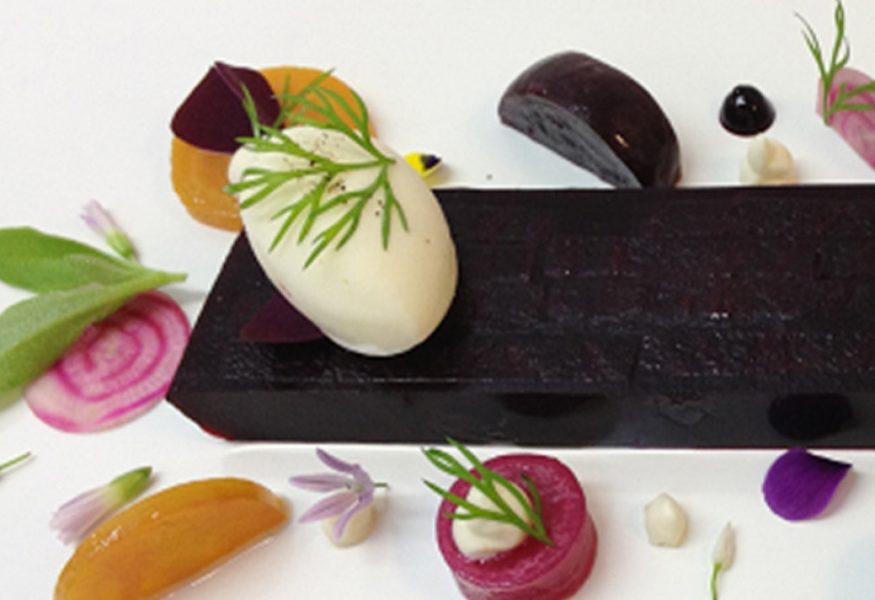
An elaborate and delicious recipe based on seasonal ingredients, which will surprise your guests on a special occasion.
Ingredients for 4 portions
- For the beetroot terrine:
- Large ruby beetroots, peeled and sliced mezzocm thick 160 g
- Ruby port 300 ml
- Beetroot juice 160 g
- Cabernet Sauvignon vinegar 16 ml
- Balsamic vinegar 16 ml
- Salt 3 g
- Pinch ground black pepper
- Agar agar 4 g
- For the beetroot garnish:
- Baby ruby beetroot, steamed and peeled 2
- Baby golden beetroot, steamed and peeled 2
- Baby candy beetroot, steamed and peeled 2
- Extra virgin olive oil 16 ml
- Chardonnay vinegar 5 ml
- Pinch caster sugar
- Salt and pepper to taste
- For the horseradish sorbet:
- Caster sugar 50 g
- Water 60 ml
- Liquid glucose 30 ml
- Crème fraîche 60 g
- Natural yoghurt 40 g
- Creamed horseradish 45 g
- Salt 2g
- Lemon juice 5 ml
- Cayenne pepper to taste
- For the horseradish puree:
- Creamed horseradish 45 g
- Crème fraiche 40 g
- Salt 2 g
- Caster sugar (pinch)
- Lemon juice 5 ml
- For the pickled beetroot:
- Baby candy beetroot, peeled and sliced 1mm 1
Preparation
For the beetroot terrine
Vacuum pack the beetroot slices and steam for 20 minutes or until tender.
Once cooled, trim the slices to fit into the terrine mould (130mm x 110mm x 60mm deep) with a gap of 1cm visible from the edge of the terrine.
Turn these out neatly onto a tray, ready to set with the jelly.
In a large saucepan, reduce the port by half and add the beetroot juice, vinegars and seasoning. Bring back to a simmer and whisk in the agar agar.
Bring back to the boil, take off the heat and pass through a fine sieve.
Set a small tester in the fridge to check the seasoning and texture of the set jelly. Adjust the seasoning if needed and use immediately, keeping the jelly hot as you build the terrine.
Pour ¾cm of the warm jelly into your terrine mould. Allow the jelly to begin to set, then add the first layer of beetroot slices.
Repeat with the remaining slices and enough jelly to cover the final layer of beetroot by 5mm.
Reserve the leftover jelly to make the purée. Make sure the jelly doesn’t completely set between the layers or your terrine will fall apart when you try and slice it.
Once the terrine has set firm, turn it out by using a large flat fish slice to push the terrine away from the edge of the mould, gently releasing it.
Slice the terrine about 1cm thick and place on a tray and cover with cling film. Reserve in the fridge until needed.
For the beetroot puree
With the remaining beetroot jelly, leave it to set firm and purée in a blender until smooth.
Pass through a muslin cloth and reserve until required.
For the beetroot garnish
Portion the beetroots in a mixture of halves, quarters or slices and keep in separate bowls.
Mix the remaining ingredients in a separate bowl and evenly distribute between the 3 bowls.
Mix thoroughly, taste and adjust the seasoning if required.
For the horseradish sorbet
Place the sugar, water and glucose in a heavy-bottom pan and bring to the boil, before leaving to cool slightly.
Add the remaining ingredients and churn in an ice cream machine. Keep in a freezer until required.
Place all the ingredients in a blender and purée until smooth.
For the pickeld beetroot
In a large bowl, mix all ingredients together and leave to marinade for a minimum of 30 minutes.
To serve
Place the terrine slice in the middle of the plate, placing the other garnishes neatly around.
Finish with a quenelle of horseradish sorbet.
Dress the plate with micro herbs and edible flowers.
To limit our impact on the environment, we advise you to remain within 1 kg CO2-equivalent per meal, including all the courses you eat. Bear in mind that plant-based dishes are more likely to have a low environmental impact.
Even though some of our suggestions exceed the recommended 1 kg CO2-equivalent per meal, that doesn't mean you should never make them; it's the overall balance that counts. Regularly eating a healthy and eco-friendly diet in the long term offsets even the dishes with the most impact, as long as you don't make them too often.

